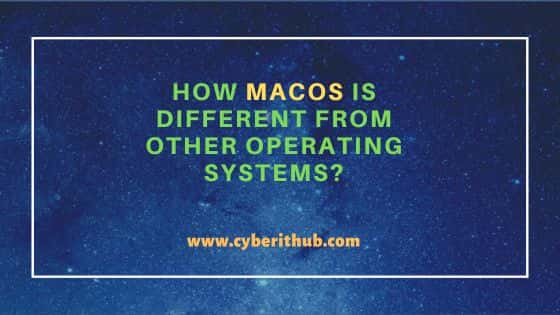Table of Contents
macOS is the operating system that powers every Mac computer, developed and marketed by Apple Inc. It's the successor to OS X and Mac OS X, and it's specifically designed to work with Apple's hardware, including MacBooks, iMacs, and Mac Pros. As a direct descendant of the original Macintosh operating system first released in 1984, macOS has evolved significantly over the years, combining a user-friendly interface with robust performance.
It is known for its sleek, intuitive, and user-friendly interface. The design is clean and visually appealing, emphasizing ease of use and accessibility. One of the strengths of macOS is its seamless integration with Apple's ecosystem, including iOS devices (iPhones and iPads), Apple Watch, and services like iCloud, Apple Music, and more. This integration allows for features like Handoff, where users can start a task on one device and continue it on another.
macOS is designed with a strong emphasis on security and privacy. Features like Gatekeeper help protect users from downloading and installing malicious software, and FileVault offers full-disk encryption for added security. It comes with a suite of powerful applications, such as Safari (web browser), Mail, Photos, and iMovie. It also includes productivity tools like Pages, Numbers, and Keynote. At its core, macOS is UNIX-based, which provides stability and robustness, making it a popular choice among software developers and IT professionals.
The Mac App Store offers a wide range of applications and games, allowing users to easily find and install new software. Siri, Apple's virtual assistant, is integrated into macOS, enabling voice commands and dictation. Apple has consistently focused on making macOS accessible to all users, including those with disabilities. Features like VoiceOver, high-contrast modes, and switch control are built into the system. Apple regularly updates macOS, not only providing security patches and bug fixes but also introducing new features, enhancements, and improvements to the system's interface and functionality.

How macOS is different from other Operating Systems?
Also Read: How to Install Terraform on macOS Using 6 Easy Steps
macOS, developed by Apple Inc., is distinct from other operating systems in several key ways. Its differences are rooted in its design philosophy, ecosystem integration, underlying technology, and user experience. Here are some of the main aspects that set macOS apart from other operating systems like Windows or various Linux distributions:-
1. Hardware and Software Integration
- Exclusive to Apple Hardware: macOS is designed to run exclusively on Apple's hardware, including MacBooks, iMacs, and Macs. This tight integration between hardware and software often results in optimized performance and a seamless user experience.
- Controlled Ecosystem: Apple controls the entire ecosystem, from the operating system to the hardware, ensuring a high level of quality and a more uniform experience.
2. User Interface and Experience
- Consistent Design: It is known for its clean, intuitive, and consistent user interface. Apple places a strong emphasis on aesthetics and user experience.
- Gesture Integration: The operating system is integrated deeply with Apple's multi-touch trackpads and other input devices, offering a range of gesture controls that enhance navigation and usability.
3. Operating System Core:
- UNIX-based: It is based on Darwin, an open-source UNIX-based operating system. This makes it stable, secure, and efficient.
- Different File System: It uses the Apple File System (APFS), optimized for SSD performance and featuring strong encryption.
4. Security and Privacy
- Sandboxing and Gatekeeper: It employs strict security measures like sandboxing for apps and Gatekeeper, which ensures only trusted software can be run.
- Regular Security Updates: Apple provides regular updates to macOS, often including enhancements to security and privacy.
5. Ecosystem Continuity
- Integration with Apple Ecosystem: It works seamlessly with other Apple products like the iPhone, iPad, Apple Watch, and Apple TV, offering features like Handoff, Universal Clipboard, and AirDrop.
- Continuity Features: These include the ability to start a task on one device and finish it on another, take calls on the Mac, and use the iPad as a secondary display with Sidecar.
6. Software Availability and Compatibility
- Exclusive Applications: Certain applications and services are exclusive to macOS (and iOS), like Safari, Final Cut Pro, and Logic Pro.
- Limited Gaming Capabilities: Historically, macOS has been less favored for gaming compared to Windows, due to limited availability of games and sometimes lesser graphics performance.
7. Innovation and Accessibility
- VoiceOver and Accessibility: macOS is lauded for its built-in accessibility features, like VoiceOver, which are highly advanced and integrated.
- Innovative Features: Apple regularly introduces innovative features in macOS, often focusing on ease of use, efficiency, and integration with its hardware and ecosystem.
Conclusion
macOS stands out due to its exclusive compatibility with Apple hardware, its emphasis on user experience and design, robust security features, and seamless integration within the Apple ecosystem. These aspects contribute to its popularity among a segment of users, particularly those already invested in Apple's ecosystem. However, the choice between macOS and other operating systems like Windows or Linux often comes down to personal preference, specific use cases, and hardware considerations.
